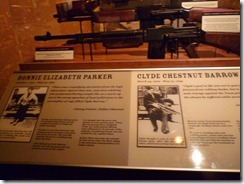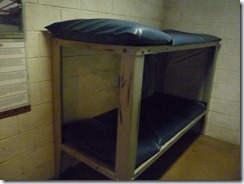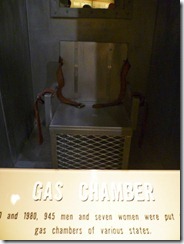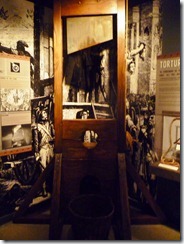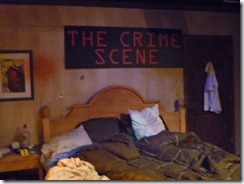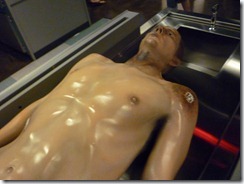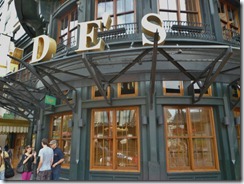Do you ever wonder if the punishment fits the crime? Come along to the Crime Museum in Washington D.C. where you can tour through a history of crime and punishment. Beginning in medieval times, you get insights into torturous implements with the items on display. Metal was popular for finger screws and iron helmets. And look at this unhappy guy stretched out in the dungeon. The different areas of the museum are made to look like their eras, a cool factor I found appealing. Also scattered throughout the place are interactive kiosks to challenge you.

Definitions of crimes have changed through the years. In Colonial times, you could get your ears nailed to the pillory for kissing on the Sabbath. That was considered lewd and unseemly behavior. This era included a poster on the Salem Witch Trials. Next we moved into Pirates, where famous pirates are described leading up to the current ones operating off the coast of Somalia.

The outlaws of the Wild West come next amid sounds of gunshots and horses neighing in the background. Billy the Kid and the Dalton Gang were famous bad guys from this era, while Wyatt Earp was a well-known law man. You could shoot rifles for a fee at a shooting range looking like the Old West.

Crimes of the Great Depression followed with the Barker Gang, Bonnie and Clyde, and Al Capone, among others. Sirens and jazz music play in the background along with machine gun fire. You can learn how to Crack-A-Safe at the interactive kiosk. Moving along, we come next to scams, hoists, and hoaxes. Then we come to the worst crime of all: murder. Apparently collectors like to obtain Murderabilia, items associated with these criminals. Can you imagine a more gruesome collection? It’s bad enough that killers become media celebrities without having people try to acquire their belongings and giving value to their fame.
Famous serial killers are mentioned in this area before we move onto conspiracy and assassinations. On the wall are posters listing all the presidents who’d been assassinated and famous kidnappings like the Lindbergh baby. There are notes from police files on famous solved crimes, including J.W. Gacy who worked as Pogo the clown. I knew there was a reason why I find clowns creepy. Computer crimes aren’t forgotten either as several of these silent criminals are mentioned. For example, Robert Morris created the first computer worm. An interactive kiosk will challenge you to see how fast you can crack a code.

Then you pass through a darkened corridor lined by brick buildings and sound effects into the history of fingerprinting, Miranda Rights, what a booking officer does, mug shots were you can get your photo taken along with some crooks, and a jail cell where you can sit on the bed. There is a meet the warden video and a display on famous prisons and great escapes. One of the dioramas shows a luxury cell where Al Capone lived in Alcatraz. Here you can play on another kiosk to see how far you can get in your escape. Death Row is mentioned as you walk into a section that looks like a prison block with sound effects and an elevated walkway. Methods of capital punishment are described dating back from medieval torture and executions through the death penalty with displays of an electric chair, a gas chamber and a guillotine.
On a better note, we come to a section on famous lawmen. Notes describe how cops communicated before 1930, their use of firearms, equipment, and the bomb squad. See how fast you can defuse a bomb at the next interactive kiosk. Technologies such as night vision and thermal imaging are described. Here we pause for patrol training. In a simulation, you can drive a cop car on a high-speed chase. Or you can fire a Glock 17 at a simulated scene, watching for the bad guy to pop up and shoot at you. After this escapade, we descend downstairs to the CSI Experience.
You are greeted by a crime scene scenario in the bedroom where a murder took place. You can push buttons to see what each piece of numbered evidence represents.
You learn about witnesses and the role of the crime lab. At a kiosk, you can play the part of a witness. What did you see?
Contents of the crime scene kit are shown. Did you know that evidence is put into brown paper bags and not plastic bags like you see on TV? Fingerprint and footprint recovery, ballistics, toxicology, dental ID, autopsy, and entomology are some of the topics touched upon. The interactive kiosk here is, Can you match the bullet?
Other crimes are discussed such as counterfeiting, art forgery, and forgery of documents. Famous cold cases has a room of its own. There’s a section on crime related TV shows, movies and books. Books by Sue Grafton, James Elroy, and Patricia Cornwall are some of the ones mentioned. Even crimes against marine animals are covered. Then we descend to the lower level that holds the studio for America’s Most Wanted television show.
I would say you need maybe 2 to 3 hours to do this museum justice. There’s a Clyde’s nearby which is great for lunch, and then you can meander over to the International Spy Museum if you’ve never visited that attraction before. The closest Metro stop to the Crime Museum is Gallery Place.
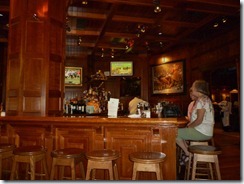
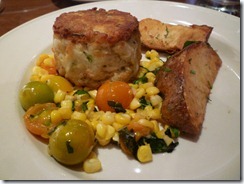

Tomorrow, join me over at the Kill Zone where I’ll be discussing Crime and Punishment.





